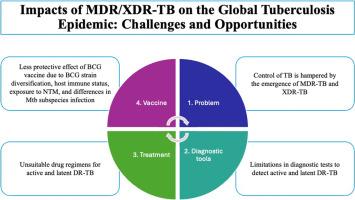MDR/XDR-TB 对全球结核病疫情的影响:挑战与机遇
IF 4.8
Q1 MICROBIOLOGY
引用次数: 0
摘要
结核病(TB)是世界上死亡率第二高的传染病。尽管有药物可以治愈结核病,但耐多药结核病(MDR-TB)和广泛耐药结核病(XDR-TB)的出现阻碍了结核病的控制。由于发现率低、治疗失败率高和死亡率高,耐多药/耐广药结核病的出现令人担忧。MDR/XDR-TB 病例不断增加的主要原因是,检测病原体药物敏感性的诊断检测存在局限性,导致疾病通过密切接触传播。此外,不一致的药物治疗或不合适的药物治疗方案也可能导致耐药性的产生。指数 MDR/XDR-TB 患者的密切接触者罹患 MDR/XDR-TB 的风险增加。此外,由于卡介苗菌株多样化、宿主免疫状态、暴露于环境中的非结核分枝杆菌(NTM)以及结核分枝杆菌(Mtb)亚种感染的差异,卡介苗可能会表现出不同的保护效果,例如北京家族基因型的Mtb会产生次优保护效果。本综述在全球结核病大流行的背景下概述了耐药结核病(DR-TB)的现状,重点关注诊断、治疗和卡介苗接种的潜在影响。它强调了当前方法的局限性,旨在确定改进结核病控制战略的机会。本文章由计算机程序翻译,如有差异,请以英文原文为准。

Impacts of MDR/XDR-TB on the global tuberculosis epidemic: Challenges and opportunities
Tuberculosis (TB) is the world's second-deadliest infectious disease. Despite the availability of drugs to cure TB, control of TB is hampered by the emergence of multidrug-resistant tuberculosis (MDR-TB) and extensively drug-resistant tuberculosis (XDR-TB). The presence of MDR/XDR-TB is alarming due to the low detection rate, high treatment failure, and high mortality. The increasing cases of MDR/XDR-TB are mainly due to the limitations in the diagnostic tests to detect the drug susceptibility of the pathogen, which contribute to the spread of the disease through close contacts. Moreover, inconsistent drug therapy or unsuitable drug regimens could also lead to the subsequent development of drug resistance. The close contacts of an index MDR/XDR-TB patient are at increased risk of developing MDR/XDR-TB. Also, the BCG vaccine may exhibit varying protective effects due to BCG strain diversification, host immune status, exposure to environmental non-tuberculous mycobacteria (NTM), and differences in Mycobacterium tuberculosis (Mtb) subspecies infection, as in the case of sub-optimal protection in the case of Beijing family genotypes of Mtb. This review provides an overview of the current state of drug-resistant tuberculosis (DR-TB) within the context of the global TB pandemic, with a focus on diagnosis, treatment, and the potential impact of BCG vaccination. It highlights the limitations of current approaches and aims to identify opportunities for improving TB control strategies.
求助全文
通过发布文献求助,成功后即可免费获取论文全文。
去求助
来源期刊

Current Research in Microbial Sciences
Immunology and Microbiology-Immunology and Microbiology (miscellaneous)
CiteScore
7.90
自引率
0.00%
发文量
81
审稿时长
66 days
 求助内容:
求助内容: 应助结果提醒方式:
应助结果提醒方式:


